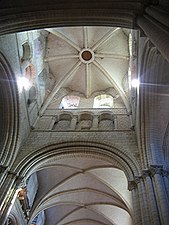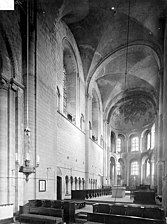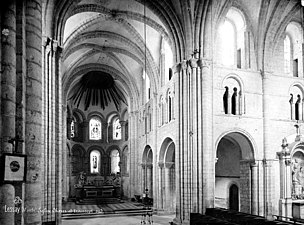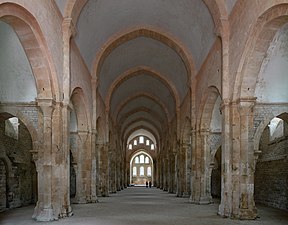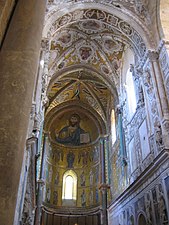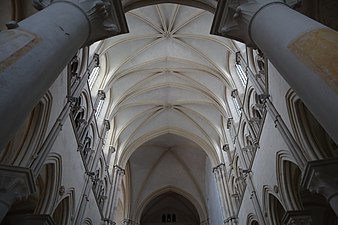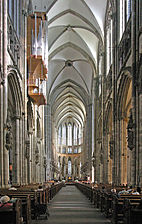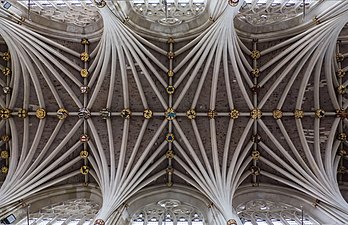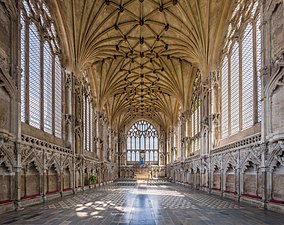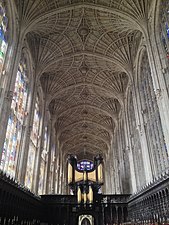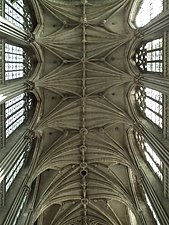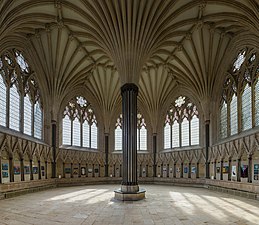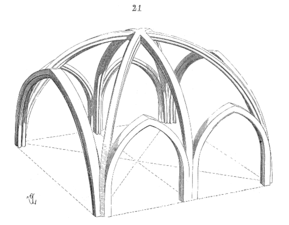Rib vault


Arib vaultorribbed vaultis an architectural feature for covering a wide space, such as achurch nave,composed of a framework of crossed or diagonal arched ribs. Variations were used inRoman architecture,Byzantine architecture,Islamic architecture,Romanesque architecture,and especiallyGothic architecture.Thin stone panels fill the space between the ribs. This greatly reduced the weight and thus the outward thrust of the vault. The ribs transmit the load downward and outward to specific points, usually rows of columns or piers. This feature allowed architects of Gothic cathedrals to make higher and thinner walls and much larger windows.[1][2]
It is a type ofarcuated,or arched,vaultin which the severies, or panels in the bays of the vault's underside are separated from one another by ribs which conceal thegroins,or the intersections of the panels.[3][4][5]Rib vaults are, like groin vaults, formed from two or three intersectingbarrel vaults;the ribs conceal the junction of the vaults.[3][4][5]
The earliest surviving example inIslamic architectureis at theMosque–Cathedral of Córdobainal-Andalus,which predates the earliestRomanesqueexamples by a century.[6][7][8]An alternative tobarrel vaultsin thenavesofchurches,rib vaults in 12th century earlyGothic architecturebegan to be used in vaults made withpointed arches,already known in the Romanesque style. In these vaults, as in groin vaults, the weight was directed it to the corners, wherepiers,columns,or walls could support it. Walls in Gothic buildings were oftenabuttedbyflying buttresses.These elements made it possible to construct buildings with much higher and thinner walls than before, with immense bays, and largerstained glasswindows filling the structure with light.[9][10][11]
Cross vaults are constructed of narrow, arched ribs that diagonally cross the area to be covered. The severies can be filled with small pieces of masonry, eliminating much of the massive weight of barrel vaults. These rib vaults could also more efficiently cover large rectangular areas. Thanks to the pointed arch employed in Gothic architecture, builders could raise or lower the arches so they would have the same height for a short span or a long span, something not possible with round arches. Pointed arches also made two intersecting vaults of the same height but different widths easier to construct.[12]
Early history
[edit]The Romans used an early version of the rib vault to strengthengroin vaults.In these Roman vaults, the brick ribs were embedded into the concrete of the vault. This was different from the later Gothic vaults, where the ribs were separate from the infilling of the panels, which gave the Gothic vaults flexibility and thus greater strength.[13]The Romans also used these embedded ribs concealed within the structure to strengthen the concrete surface of domes, such as thePantheon.[14]
Rib vaults were not common in masonry buildings inByzantine architecture,but four ribbed vaults were built by theHosios Loukasmonastery inByzantine Greeceafter 1000 AD, and at the now ruined town Çanlı Kilise in ByzantineCappadociaseveral groin vaults in medieval churches are equipped with ribs.[15]A number of other rib vaults were built in Greece under theFrankokratiaafter theFourth Crusade.[15]Rib vaults were also known inLombard,Armenian,Persian,andIslamic architecture.[15]
Cross vaults
[edit]Roman architecture
[edit]The first known example of ladder ribs used on cross vaults is the one documented in theVilla of the Sette Bassiin Rome, dating from the mid-second century AD.[16]

Islamic architecture
[edit]In theMoorish architectureof Spain, Islamic architects used these ribbed vaults more visibly. One notable example is found in theGreat Mosque of Córdoba,which was begun in the 9th century and extended between 922 and 965 byAl-Hakam II.[17]The Chapel of Villaviciosa, as this part of the mosque became known when it was converted to aRoman Catholicchurch in the 13th century, has a dome which rests upon ribs andpendentives.[17]At eachvertexof the square is the intersection with another arch, such that each intersection is the junction of three arches.[17]At each corner is a further miniature cross-vault dome.[17]In the other domes of the 10th century reconstruction of the Great Mosque, the ribs intersect one another off-centre, forming an eight-pointed star in the centre which is topped by a pendentive dome.[7]
The crossed-arch vaults of the mosque-cathedral of Córdoba served as models for later mosque buildings in the Islamic West, includingal-Andalusand theMaghreb.At around 1000 AD, theMezquita de Bab al Mardum(Mosque of Cristo de la Luz) inToledowas constructed with a similar, eight-ribbed vault.[17]The dome is supported both by the ribs and by pendentives that transmit its weight to the walls below.[17]Similar vaults are also seen in the mosque building of theAljaferíaofZaragoza.[citation needed]The architectural form of the ribbed vault was further developed in the Maghreb: the central dome of theGreat Mosque of Tlemcen,a work of theAlmoravidsbuilt in 1082, has twelve slender ribs, the shell between the ribs is filled with filigree stucco work.[7]TheAlmohadsalso expanded its use to military structures, as exemplified in theAtalaya CastleinVillena.[18]
-
Chapel of Villaviciosa,Great Mosque of Cordoba(962–965)
-
Mosque of Cristo de la Luz,Toledo, Spain(c. 1000)
Romanesque architecture
[edit]The rib vault was developed further in northern Europe in the 11th century, as builders sought a way to construct larger and larger stone vaults to replace the wooden roofs of Romanesque churches, which were frequently destroyed by fire. Romanesque cathedrals and churches usually used thebarrel vault,with rounded arches, and thegroin vault,used when two vaults met at a right angle to cover the nave. The weight of the vaults pressed down directly onto the walls below, requiring thicker walls and smaller windows.[19]
Saint-Philibert de Tournushas exceptional Romanesque vaults, built between 1008 and 1050. The nave and chapel have parallel traverse tunnel vaults, while the aisles of both interiors are groin-vaulted.[19]
Speyer Cathedralin Germany is the largest of all existing Romanesque churches in Europe, and has good examples of Romanesque barrel vaults and groin vaults in the nave. The groin vaults were built in 1060, and but had to be reinforced in 1090–1103 with a traverse arch between each arch.[20]
TheKingdom of Englandand theDuchy of Normandybecame centres of architectural innovation in the late 11th century. Even before theNorman Conquestin 1066, KingEdward the Confessorof England had introduced Romanesque features toWestminster Abbey(1055–65).[21]William the Conquerorconstructed the domes of theAbbey of Saint-Étienne, Caenwith a kind of crossed rib vault, a star vault, in its central lantern.[21]TheAbbaye-aux-Damesalso in Caen, was roofed with two large bays of stonegroin vaultsin the 1080s, one of the earliest uses in Europe of a groin vault to cover such a wide span.[21]
-
Romanesque vaults ofSaint-Philibert de Tournus(1008–1050)
-
Romanesque nave and vaults ofSpeyer Cathedral(1082–1103)
-
Groin vault with ribs at Sainte-Croix Abbey church ofQuimperlé,Brittany (1083)
-
Star vault,Abbey of Saint-Étienne, Caen(1065–1166)
-
Groin vaults of the choir of theAbbaye-aux-Dames(1080s)
Transition to Gothic architecture
[edit]Construction of the new church atDurham Cathedralbegan in 1093 under the direction of its Norman bishop,William de St-Calais.[22]It was originally intended to build the cathedral entirely with rounded-arch groin vaults, but as work continued on the nave the Norman builders experimented with pointed arches, which directed the weight outward and downwards.[22]The space between the ribs was filled with severies made of small pieces of stone.[22]At its corners the weight was supported bycolonetteswhich transferred it downwards to alternating columns and piers below rather than to the walls. Since the panels are relatively thin, these rib vaults are lighter than the earlier barrel and groin vaults so the walls could be higher and could have larger windows.[22]
The work began at the east end of Durham Cathedral; the vaults over the aisles were complete in 1096, and over the choir by 1107.[22]The nave vaults, with pointed arches, were begun in about 1130. Thanks to the pointed arches, the upper level of the clerestory seemed to merge into the roof in a unified whole.[22]The Durham experiment, however, quickly ran into problems. The vault panels in the chancel were made of plastered rubble, and were heavier than expected, and began to crack, and had to be replaced in 1235.[22]In the meanwhile, experimentation in pointed rib vaults moved to France, where thinner and lighter panels were made of small cut pieces of stone, rather than rubble.[23]
The RomanesqueLessay Abbeyin Normandy added early Gothic rib vaults in the choir in about 1098. which covered portions of the choir and nave.[24]It was destroyed in World War II but rebuilt.[25]The dome of the RomanesqueChurch of the Holy Sepulchre, Cambridgein England, begun in 1130, has ribs in the dome, though the dome rests uponpendentives,and the ribs were largely decorative.[24]The RomanesqueCefalù Cathedralin the NormanKingdom of Sicily,begun in 1131, has a Gothic rib vault.[2][26]
The transition from Romanesque to Gothic can also be seen in the nave ofFontenay Abbeychurch (1147), where the round arches of the barrel vaults have been replaced by vaults with slightly pointed arches.[27]
-
Nave ofDurham Cathedral,(1093–1135)
-
Early rib vault in east end ofLessay Abbey,Normandy (about 1098) (photo from before World War II)
-
Nave ofVézelay Abbey,(1104–1132) with Romanesque groin vaults in the nave (foreground) and Gothic rib vaults in the choir (background)
-
Vaulted church ofFontenay Abbey(1130–1147)
-
Norman-Gothic vaults in choir ofCefalù Cathedral(1131–1240)
Other variations of rib vaults, usually with rounded arches, appeared inLombardyin theBasilica of Sant'Ambrogio,Milan, at the end of the 11th century, and in Southwest France atMoissac Abbey(11th-12th century).[28]These were usually groin vaults, composed by joining two barrel vaults at right angles.[13]Other types of vaults were decorative, such as the star vaults used to decorate the lantern tower on the roof ofCaen CathedralandLaon Cathedral,or the ribs on the interior of the dome of the Round Church in Cambridge (1130).[13]
-
Sainte-Croix Abbey church ofQuimperlé(1083)
-
Church of the Holy Sepulchre, Cambridge (c. 1130)
-
Star vault,Caen Cathedral(1065–1166)
-
Lantern vault,Laon Cathedral(1150s–1230)
-
Basilica of Sant'Ambrogio(12th century)
Sexpartite vaulting
[edit]In sexpartite vaulting, each bay was divided by thin stone ribs into six compartments. The intermediate ribs diagonally crossing the vault formed a pointed arch, and there was an additional intermediate pointed arch, which crossed from side to side. Since the ribs carried the weight, the panels of the vaults were made of small pieces of stone, and were much lighter than traditional barrel vaults.[29]The ribs transmitted the weight outwards and downwards through slender columns to the piers on the lower level. The weight was not distributed equally; the additional weight of the diagonal traverse arches was supported by massive piers, while the intermediate crossing arch was supported by simple columns.[2]Since the weight of the vaults was carried by the columns and piers, not the walls, the walls could be thinner and higher, and they could be filled with larger stained glass windows.[2][26][29]
Thesexpartite vaultappeared almost simultaneously in England and France. The first cathedral to use sexpartite vaults wasDurham Cathedral,begun in 1093. Durham was originally intended to be built with more traditional groin vaults. The vaults over the aisles were completed in 1096, those over the choir in 1107, these over the north transept and 1110. The traverse vaults of the nave, however, the arches over the south transept and nave, begun 1130, were given pointed arches.[22][30]Early examples of sexpartite rib vaults are found at the Abbaye-aux-Hommes (begun 1066) and Abbaye-aux-Dames atCaen.It then appeared inNoyon Cathedral(begun 1131); the square Gothic porch of the Romanesque church ofVézelay Abbeyin France (1132);Sens Cathedral(begun 1135); the choir of theAbbey of Saint-Denis(begun 1140);Notre-Dame de Paris(begun 1163);Bourges Cathedral;andLaon Cathedral.Ribbed vaults were built byWilliam the EnglishmanatCanterbury Cathedraland in St Faith's Chapel inWestminster Abbey(1180).[31][failed verification][32][33][29]
-
Six-part rib vaults in the narthex ofVézelay Abbey(1132)
-
Ambulatory of theBasilica of Saint-Denis(completed 1144)
-
Six-part rib vaults of ceiling of nave ofNotre-Dame de Paris(1163–1345)
-
Sexpartite rib vaults inSens Cathedral(1135–1164)
-
Cefalù Cathedral(1131–1240), with rib vault in thechancelat east end
-
Six-part rib vaults of ceiling of theCathedral of Santo Domingo(1504–1550), Dominican Republic
Quadripartite vaulting
[edit]A new variation of rib vault appeared during the High Gothic: the four-part rib vault, which was used inChartres Cathedral,Amiens CathedralandReims Cathedral.[29]The ribs of this vault distributed the weight more equally to the four supporting piers below, and established a closer connection between the nave and the lower portions of the church walls, and between the arcades below and the windows above.[29]This allowed for greater height and thinner walls, and contributed to the strong impression of verticality given by the newer Cathedrals.[29]The 11th centuryDurham Cathedral(1093–1135), with the earlier six-part rib vaults, is 73 feet (22 meters) high. The 12th-century nave ofNotre-Dame de Paris,also with six-part rib vaults, is 115 feet, or 35 meters high.[34]The laterAmiens Cathedral(built 1220–1266), with the new four-part rib vaults, has a nave that is 138.8 feet (42.3 meters) high.[34]The tallest nave of all the Gothic Cathedrals isBeauvais Cathedral,though only a single bay was completed. It is 47.5 m (156 ft) in height, slightly taller than the nave ofSt Peter's Basilicain Rome.[34]
-
Four-part rib vaults atAmiens Cathedral(1220–1270) allowed greater height and larger windows
-
Stronger four-part rib vaults atRouen Cathedral(13th c.)
-
The choir ofBeauvais Cathedral(1225–1272), the tallest of Gothic church interiors.
-
Nave ofCologne Cathedral(1248–1322)
-
Hall of the guards of theConciergerie,part of the earlier royal palace, in Paris (13th century)
Complex rib vaults
[edit]Beginning in England with theDecorated Gothicstyle of the late 13th century, a variety of complex vaults emerged which incorporated purely decorative ribs in addition to structural ones. Vaults would continue to increase in complexity in the Perpendicular period, and similarly extravagant rib vaulting would appear in other late Gothic styles such as theFlamboyantin France andSondergotikin Central Europe.
Tierceron vaults make use of tertiary ribs (tiercerons) in addition to the main structural ribs of the regular quadripartite vault. This can be seen in the Decorated Gothic nave ofExeter Cathedral,begun in 1310; the massive vault has a profusion of tierceron ribs like palm leaves, with as many as eleven tiercerons curving upward from a singlespringer.[35]An octagonal tierceron vault completed in 1306 roofs the chapter house ofWells Cathedral,where 32 ribs spring from a single central pillar. AtEly Cathedral(1322–1342), tiercerons decorate the (wooden) vault of the octagonal lantern over the crossing.[36][29]
Liernevaults also feature prominently in the Decorated and Perpendicular Gothic architecture of England. Liernes are very short decorative ribs that connect one rib to another. Most lierne vaults incorporate both liernes and tiercerons, resulting in intricate designs resembling stars, webs, nets, or other patterns. The Perpendicular Gothic choir ofGloucester Cathedralfeatures an extremely complex net-like vault covered completely in liernes, while the Lady Chapel of Ely Cathedral has a vault of liernes concentrated mainly around the centreline of the ceiling.
The Perpendicular Gothicfan vaultis a unique type of rib vault particular to England.[citation needed]The ribs are all of the same curve and spaced equidistantly, in a manner resembling a fan. Thus, unlike gothic vaults derived from pointed arches, the fan vault is composed of semicircular conoids. The earliest example of fan vaulting is in the cloisters of Gloucester Cathedral. TheKing's College Chapel,Cambridge, has the world's largest fan-vaulted ceiling.[citation needed]
-
Tierceron vault in the nave ofExeter Cathedral
-
Lierne vault in the Lady Chapel ofEly Cathedral(begun 1321)
-
Liernevault in the choir ofGloucester Cathedral(1331)
-
Lierne vault in the nave ofCanterbury Cathedral(late 14th century)
-
Late Gothic star vault of theMonastery of Batalha,Portugal (1386)
-
Fan vault in the chapel ofKing's College, Cambridge(1446–1554)
-
Tierceron vault in the Church of Saint-Pierre, Caen (15th century)
-
Fan vault inBath Abbey(mostly 19th century)
-
Tierceron vault in the chapter house ofWells Cathedral
-
Decorative rib vault in the hall ofPrague Castle
Function
[edit]-
Structure of a six-part Gothic rib vault (Drawings byEugène Viollet-le-Duc) The six-part vault could cover two bays of the nave, but required alternating pillars and columns to support the difference of weight distributed by the traverse and diagonal ribs.
-
The dynamics of a rib vault, with outward and downward pressure from ribs balanced by columns and buttresses. The pieces in the model can stand by themselves, without cement. (National Museum of French Monuments, Paris)
-
Rib vaults support the roof; they transfer the force of the weight outwards and downwards through a web of thin stone ribs, connected by thin pillars to the piers and columns below and to buttresses outside
The development of the rib vault was the result of the search for greater height and more light in the naves of cathedrals. In Romanesque cathedrals, the nave was typically covered by a series ofgroin vaults,which were formed by the intersection of twobarrel vaults.The vaults pressed down directly onto the walls. The groin vaults werebombée,or roughly dome-shaped. To support the weight of the vaults, the walls had to be particularly thick, and windows were absent or very small. This problem was resolved in the early 11th century by the introduction of the Gothic rib vault.[12][33]
Rib vaults are reinforced by a network of thin stone ribs (French:ogives). In the first six-part vaults, the vault was supported by two diagonal crossing ribs, plus an intermediate rib, which together divided the vault into six sections. The diagonal ribs were in the form of semicircular arches, which raised the centre of the vault above the level of thetransverse archesand wall ribs, and gave it the appearance of a small dome. (This kind of vault can be seen in the nave of Sant' Ambrogio, Milan). In some new churches, the architects dealt with the problem by raising the upper part of their arches was raised. This was tried in some of the earliest Gothic churches, notably the Abbaye-aux-Hommes and the Abbey of Lessay in Normandy.[12]

The problem was ultimately solved by the introduction of thepointed archfor the transverse and dividing ribs of the vault. The pointed arch had long been known and employed, on account of its much greater strength and of the lessened thrust it exerted on the walls. When employed for the ribs of a vault, however narrow or wide the span might be, by adopting a pointed arch, its summit could be made to match the height of the diagonal ribs.[12]The ribs carried the weight of the vault outwards and downwards. The ribs were bundled into columns, each combining four ribs, which descended the walls to the arcades on piers on the ground floor. Outside, the walls were given greater strength by the addition of heavy stone buttresses. The strength of rib vaults made it possible to have thinner walls, which in turn made it possible to have larger windows on the upper levels, filling the nave with light. They eventually made possible the enormousrose windowsof Gothic cathedrals.[33]
This six-part vault was successfully introduced inNoyon Cathedral,Laon Cathedral,and Notre-Dame de Paris. A single six-part vault could cover two traverse sections of the nave of Notre-Dame. However, the six-rib vault had its problems. The weight was not distributed evenly to the columns on the ground floor. When a vault covered two traverses, more massive piers were needed to bear the weight from thedoubleaux,the diagonal ribs, than for the intermediate ribs. This problem was solved by simplifying the vault and eliminating the intermediate rib, making a four-part or quadripartite rib vault. Under this system, which was promptly used at Amiens Cathedral, Reims Cathedral and many others, each traverse section had just one four-part vault. This innovation, along with the use of theflying buttress,saw Gothic cathedral walls go higher and higher, with larger and larger windows.[33]
The simplification of the rib vault was soon followed, particularly in England, by another tendency – to make them more complicated. One of the earliest examples of the introduction of the intermediate ridge rib is found in the nave ofLincoln Cathedral;This element, called a ridge rib, was not connected to the walls. Architects in England began adding new ribs, largely for decoration. In the nave ofExeter Cathedralthree intermediate ribs were provided between the wall rib and the diagonal rib. In order to mask the junction of the various ribs, their intersections were ornamented with richly carved bosses, and this practice increased with the introduction of another short rib, known as lierne vaulting. The lierne, a term in France given to the ridge rib, in English refers to short ribs that cross between the main ones; these were employed chiefly as decorative features, for example in stellar vaults, one of the best examples of which is in the vault of the oriel window ofCrosby Hall, London.Ribs came more and more numerous and more and more decorative leading to the extraordinarily elaborate and decorative fan vault, first used in the choir ofGloucester Cathedral.[12]
Construction
[edit]
The first step in the construction of a vault was a wooden scaffold up to the level of the top of the supporting columns. Next, a precise wooden frame was constructed on top of the scaffold in the exact shape of the ribs (French:nervures). The stone segments of the ribs were then carefully laid into the frame and joined with mortar. When the ribs were all in place, thekeystonewas placed at the apex where they converged. Once the keystone was in place, the ribs could stand alone, supported by their weight pressing downwards and outwards. Workers then filled in the compartments between the ribs with small fitted pieces of brick or stone. The framework was removed. The masonry of the compartments was about 15 cm thick. Once the compartments were finished, their interior surface was plastered and then painted.[37]
The construction of a medieval rib vault was a complex operation involving a team of specialized workers. The masons included hewers (French:taileurs), who cut the stone;poseurs,who set the stones in place; and layers (morteliers), who joined the pieces together with mortar. These craftsmen worked alongside carpenters who built the complex scaffolds and models.[37]
See also
[edit]Notes and citations
[edit]- ^Encyclopædia Britannica on-line "Gothic architecture - Ribbed vault" (retrieved June 4, 2020)
- ^abcdRenault & Lazé 2006,pp. 34–35.
- ^ab"rib vault".Sir Banister Fletcher Glossary(21st ed.). London: Bloomsbury Publishing. 2018.doi:10.5040/9781350122741.1002114.ISBN978-1-350-12274-1.Retrieved2020-05-26.
Form of constructing roofs in Romanesque and Gothic architecture whereby two or three barrel vaults intersect, with the edges producing a series of thin pointed ribs, usually of stone and highly decorated.
- ^abCurl, James Stevens; Wilson, Susan, eds. (2015)."vault".A Dictionary of Architecture and Landscape Architecture(3rd ed.). Oxford University Press.doi:10.1093/acref/9780199674985.001.0001.ISBN978-0-19-967498-5.Retrieved2020-05-26.
with ribs framing the webs and concealing the groins
- ^abCurl, James Stevens, ed. (2006)."ribbed vault".A Dictionary of Architecture and Landscape Architecture(2nd ed.). Oxford University Press.doi:10.1093/acref/9780198606789.001.0001.ISBN978-0-19-860678-9.Retrieved2020-05-26.
Any vault with an under-surface subdivided by ribs framing the severies or webs.
- ^Giese, Pawlak & Thome 2018.
- ^abcGiese-Vögeli 2007.
- ^Harbison 2009,p. 103.
- ^Renault & Lazé 2006,pp. 33–38.
- ^Ducher 2014,pp. 40–42.
- ^Mignon, Olivier,Architecture des Cathédrals Gothiques(2015), p. 10
- ^abcdeChisholm, Hugh, ed. (1911). "Rib Vault". Encyclopædia Britannica. 23 (11th ed.). Cambridge University Press.
- ^abcO'Reilly 1921,Note 11.
- ^Watkin 1986,p. 94.
- ^abcOusterhout, Robert G. (2005).A Byzantine Settlement in Cappadocia.Washington, D.C.: Dumbarton Oaks. p. 167.ISBN978-0-88402-310-4.
- ^Amici, Carla Maria (2019-01-01)."Vaulting Ribs in Roman Architecture: Invention, Use and Evolution".Proceedings of the CHS 6th Conference.
- ^abcdefFuentes, Paula; Huerta, Santiago (2016-07-03). "Geometry, Construction and Structural Analysis of the Crossed-Arch Vault of the Chapel of Villaviciosa, in the Mosque of Córdoba".International Journal of Architectural Heritage.10(5): 589–603.doi:10.1080/15583058.2015.1025456.ISSN1558-3058.S2CID107069160.
- ^FERRE DE MERLO, Luis (2000)."Bóvedas nervadas en el Castillo de Villena (Alicante)"(PDF).Actas del Tercer Congreso Nacional de Historia de la Construcción(in Spanish). Madrid, Sevilla, Granada. Archived fromthe original(pdf)on 11 December 2009.Retrieved14 October2009.
- ^abWatkin 1986,p. 99.
- ^Watkin 1986,p. 96.
- ^abcWatkin 1986,p. 105.
- ^abcdefghWatkin 1986,p. 108.
- ^Watkin 1986,pp. 108–109.
- ^ab"gothique".Encyclopédie Larousse en ligne(in French).Retrieved2020-06-15.
- ^Bechmann 2017,pp. 188–190.
- ^abBechmann 2017,pp. 163–71.
- ^"voûte sur croisée d'ogives".Encyclopédie Larousse en ligne(in French).Retrieved2020-06-15.
- ^"Le Guide du Patrimoine de France", Editions du Patrimoine, Centre des Monuments Historique, p. 472 (2009)
- ^abcdefgRenault & Lazé 2006,p. 34.
- ^Ching, Francis D.K. (1995).A Visual Dictionary of Architecture.John Wiley and Sons. p. 263.ISBN0-471-28451-3.
- ^pixeltocode.uk, PixelToCode."What to see and do".Westminster Abbey.Retrieved2020-06-10.
- ^Gardner's Art Through the Ages,(2006), Ch. 13. Gothic Art: "Architectural Basics" p. 352.
- ^abcdDucher 2014,p. 40.
- ^abcWatkin 1986,p. 134.
- ^Watkin 1986,p. 149.
- ^Watkin 1986,p. 150.
- ^abBechmann 2017,p. 206.
Bibliography
[edit]- Bechmann, Roland (2017).Les Racines des Cathédrales(in French). Payot.ISBN978-2-228-90651-7.
- Ducher, Robert (2014).Caractéristique des Styles(in French). Flammarion.ISBN978-2-0813-4383-2.
- Giese, Francine; Pawlak, Anna; Thome, Markus (2018).Tomb – Memory – Space: Concepts of Representation in Premodern Christian and Islamic Art(in German). Walter de Gruyter GmbH & Co KG.ISBN9783110517347.
- Giese-Vögeli, Francine (2007).Das islamische Rippengewölbe: Ursprung, Form, Verbreitung[Islamic rib vaults: Origins, form, spread] (in German). Berlin: Gebr. Mann.ISBN978-3-7861-2550-1.
- Harbison, Robert (2009).Travels in the History of Architecture.Reaktion Books.ISBN9781861896902.
- Mignon, Olivier (2017).Architecture du Patrimoine Française – Abbayes, Églises, Cathédrales et Châteaux(in French). Éditions Ouest-France.ISBN978-27373-7611-5.
- O'Reilly, Elizabeth Boyle (1921).How France Built Her Cathedrals – A study in the Twelfth and Thirteenth Centuries.Harper and Brothers.
- Renault, Christophe; Lazé, Christophe (2006).Les Styles de l'architecture et du mobilier(in French). Gisserot.ISBN9-782877-474658.
- Texier, Simon, (2012),Paris Panorama de l'architecture de l'Antiquité à nos jours,Parigramme, Paris (in French),ISBN978-2-84096-667-8
- Watkin, David (1986).A History of Western Architecture.Barrie and Jenkins.ISBN0-7126-1279-3.
- Wenzler, Claude (2018),Cathédales Gothiques – un Défi Médiéval,Éditions Ouest-France, Rennes (in French)ISBN978-2-7373-7712-9







